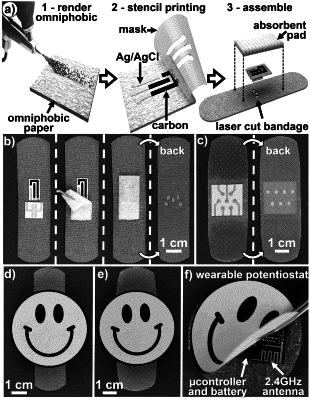| CPC A61B 5/1477 (2013.01) [A61B 5/0022 (2013.01); A61B 5/0531 (2013.01); A61B 5/14539 (2013.01); A61B 5/14546 (2013.01); A61B 5/4266 (2013.01); A61B 5/447 (2013.01); A61B 5/6802 (2013.01); A61B 5/14517 (2013.01); A61B 5/6833 (2013.01); A61B 2562/0215 (2017.08)] | 3 Claims |

|
1. A method of detecting a condition of a wound or a pressure ulcer in the skin of a subject by (i) attaching a device to the wound or area of the pressure ulcer, wherein the device comprises:
a bandage comprising a first surface configured to face healthy skin or wounded tissue, and a second surface on an opposite side of the first surface;
a detachable potentiostat, which is attached to the second surface of the bandage and includes an electrochemical sensing application chip and an impedance analyzer chip to detect the condition of the wound or the pressure ulcer;
a porous, chemically modified omniphobic pad comprising a first side configured to be attached to the first surface of the bandage, and a second side that is on an opposite side of the first side;
an absorbent pad, wherein the absorbent pad is deposed on the second side of the porous, chemically modified omniphobic pad;
a sensor deposed between the absorbent pad and the second side of the porous, chemically modified omniphobic pad, wherein the sensor comprises a working electrode, a counter electrode, and a reference electrode, wherein the electrodes are stencil-printed on the porous, chemically modified omniphobic pad; and,
when the condition of the wound is to be detected, dropcasting a PANi-EB/Ag comprising a polyaniline-emeraldine base and silver microflakes composite film between the electrodes, wherein the silver in the PANi-EB/Ag composite film has a particle size of 2-5 μm, and when the condition of the pressure ulcer is to be detected, dropcasting a hydrogel between the electrodes;
wherein the detachable potentiostat is configured to be connected to the sensor through a plurality of pathways on the bandage to enable communications between the detachable potentiostat and the sensor; and
(ii) when the condition of the wound is to be detected, measuring a pH of a wound exudate by impedance spectroscopy, and when the condition of the pressure ulcer is to be detected,
measuring a magnitude and a phase of an impedance by surface mapping before the pressure ulcer is visible on a surface of the skin of the subject and correlating the magnitude and the phase of the impedance to a degree of tissue damage caused by the pressure ulcer; and
iii) monitoring the condition of the wound or the pressure ulcer with a mobile device.
|